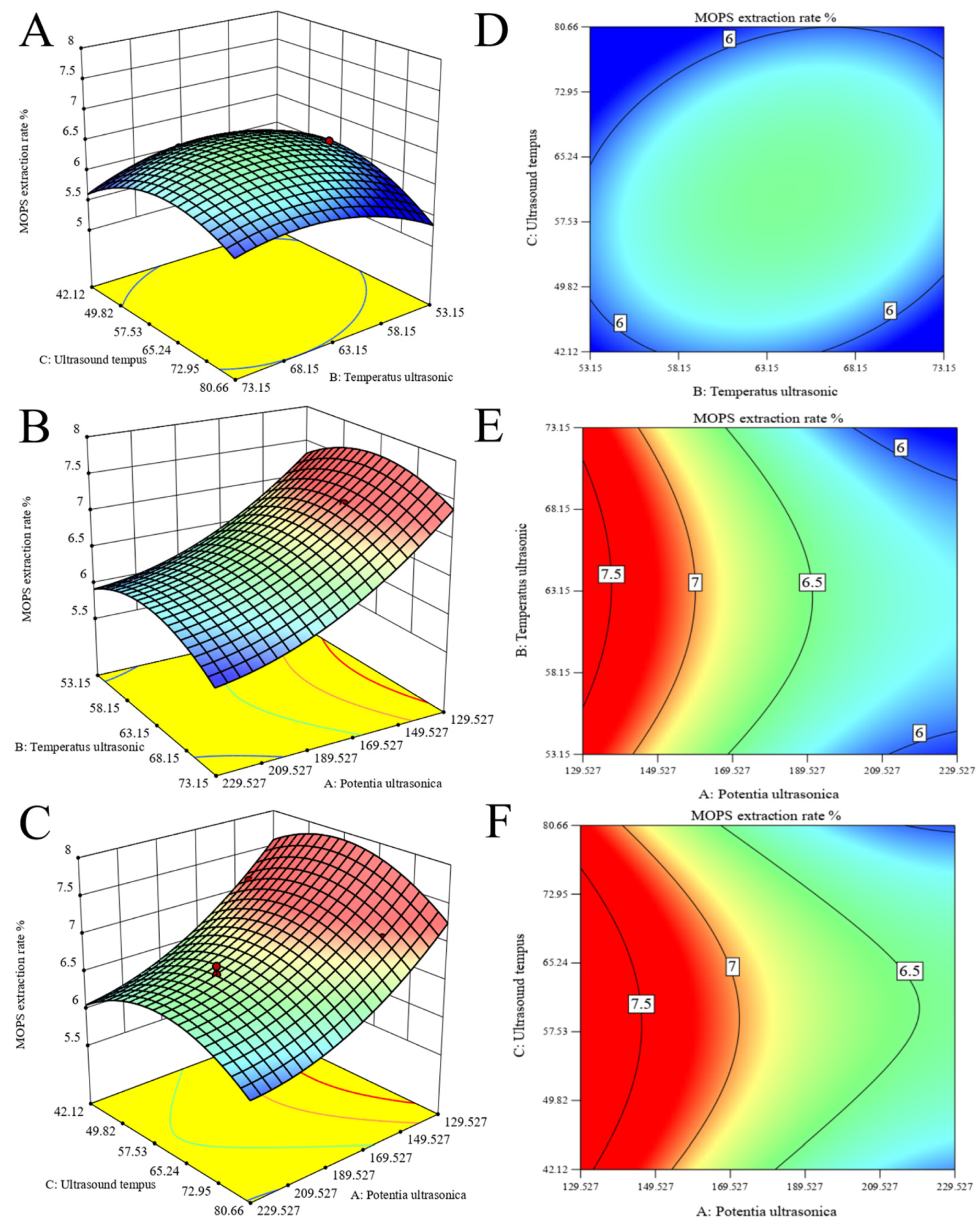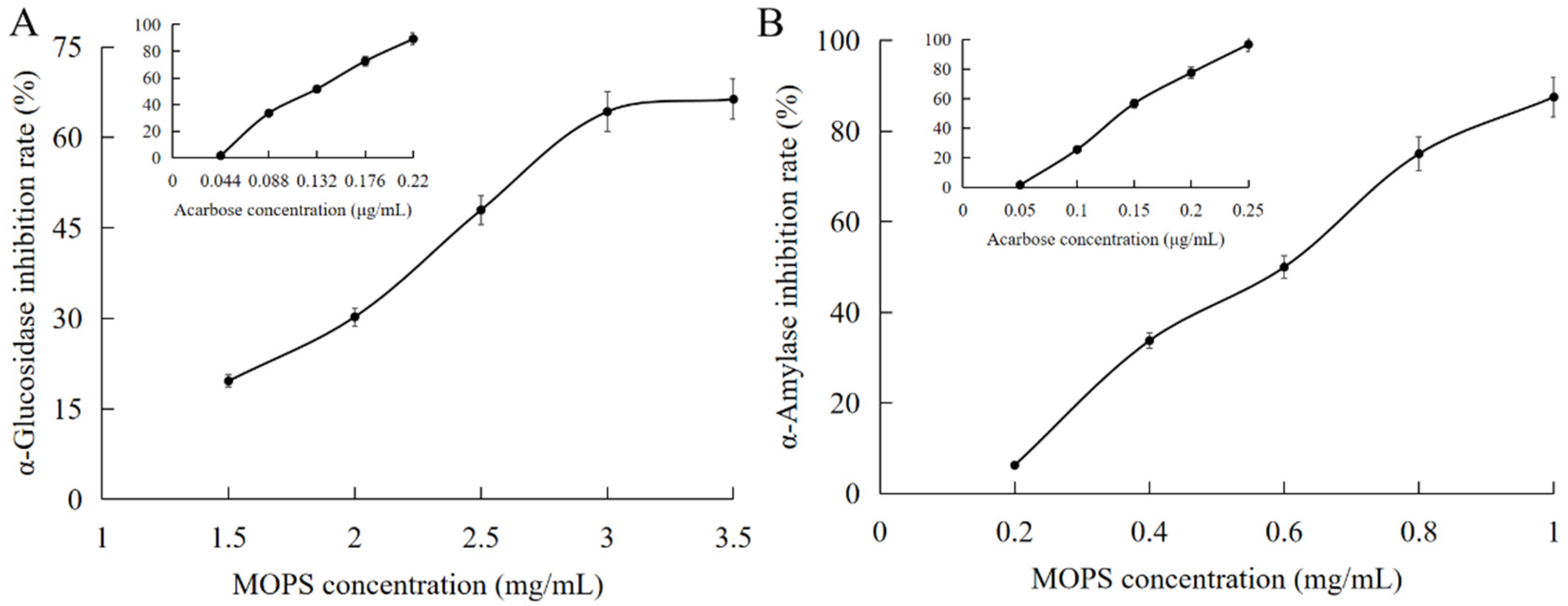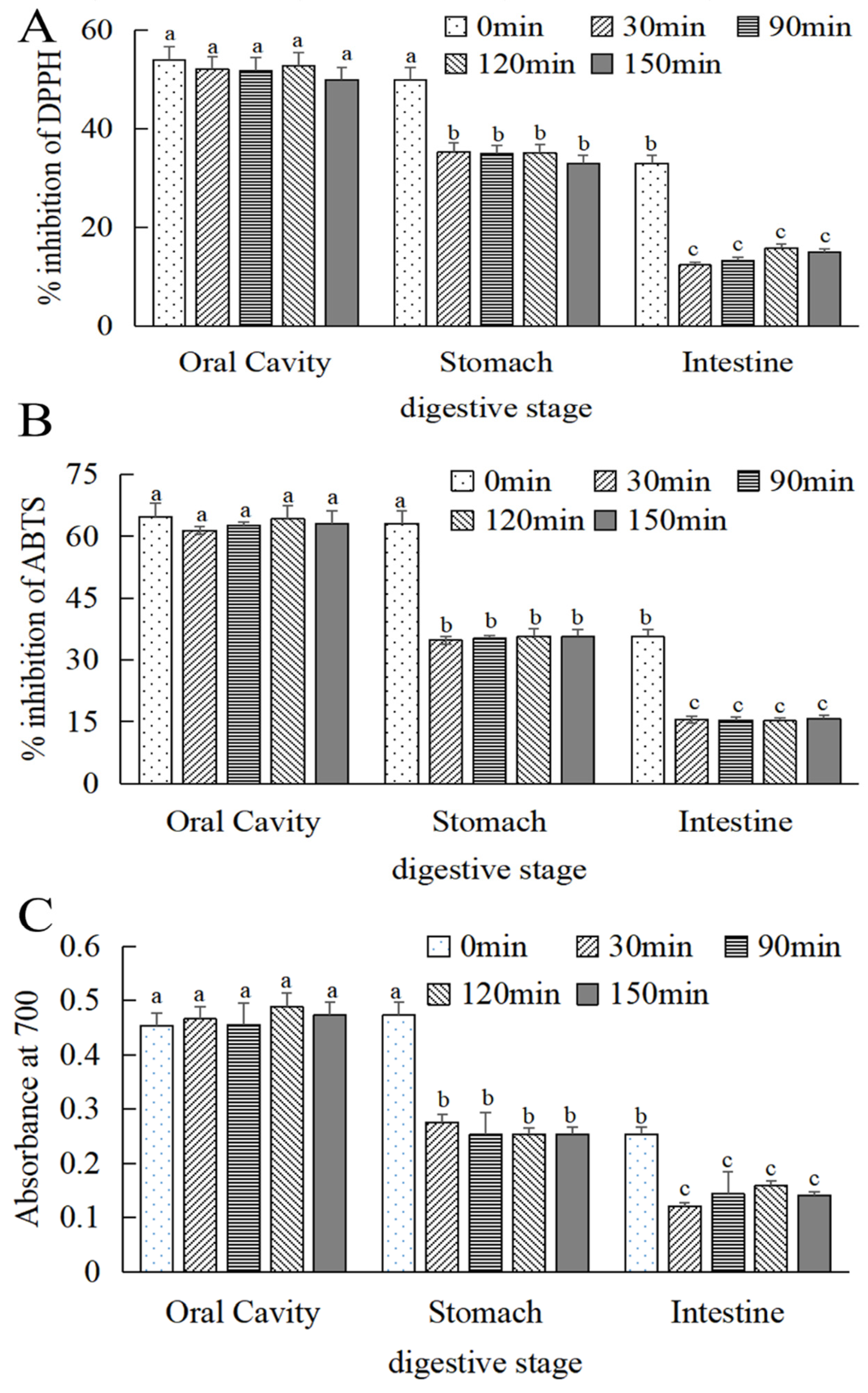Ultrasonic-Assisted Extraction and Gastrointestinal Digestion Characteristics of Polysaccharides Extracted from Mallotus oblongfolius
Abstract
:1. Introduction
2. Materials and Methods
2.1. Materials and Chemicals
2.2. Extraction of MOPS
2.3. Calculation of MOPS Yield
2.3.1. Drawing of Standard Curve
2.3.2. Determination of MOPS Content
2.4. Optimization of MOPS Extraction Process
2.4.1. Single Factor Experimental Design
2.4.2. Response Surface Experimental Design
2.5. Determination of Antioxidant Activity of MOPS
2.6. Determination of Hypoglycaemic Activity of MOPS
2.7. The MOPS Experiment Simulates In Vitro Digestion
2.7.1. Vitro Simulation of Oral Digestion
2.7.2. Vitro Simulation of Gastric Digestion
2.8. Vitro Simulation of Enteral Digestion
2.9. Statistical Analysis
3. Results and Analysis
3.1. Results of the Single-Factor Test
3.2. Response Surface Optimization of MOPS Extraction Experiment
3.2.1. Regression Equations
3.2.2. Response Surface Analysis
3.2.3. Optimized Process Validation Experiments
3.3. Antioxidant Effects of MOPS
3.3.1. Free radical Scavenging and Reducing Capacity of MOPS
3.3.2. Hypoglycaemic Effect of MOPS
3.4. Simulation of In Vitro Digestion of MOPS
3.4.1. Polysaccharide Content
3.4.2. Antioxidant Properties of MOPS
3.4.3. Hypoglycaemic Activity of MOPS
4. Discussion
Author Contributions
Funding
Institutional Review Board Statement
Informed Consent Statement
Data Availability Statement
Conflicts of Interest
References
- Liu, T.; Chen, D.; Liu, Z.; Hou, J.M. First Report of Colletotrichum siamense Causing Anthracnose on Partridge tea (Mallotus oblongifolius) in China. Plant Dis. 2018, 102, 1669. [Google Scholar] [CrossRef]
- Li, S.R.; Song, Y.J.; Deng, R.; Li, X.W.; Cheng, Y.; Zhang, Z.Q.; Sun, F.Y.; Liu, Q.S. Mallotus oblongifolius extracts ameliorate ischemic nerve damage by increasing endogenous neural stem cell proliferation through the Wnt/beta-catenin signaling pathway. Food Funct. 2020, 11, 1027–1036. [Google Scholar] [CrossRef] [PubMed]
- Li, S.; Zhang, W.; Wang, R.; Li, C.; Lin, X.; Wang, L. Screening and Identification of Natural A-Glucosidase and A-Amylase Inhibitors from Partridge Tea (Mallotus furetianus Muell-Arg) and in Silico Analysis. Food Chem. 2022, 388, 133004. [Google Scholar] [CrossRef] [PubMed]
- Yu, S.; Duan, Z.; Li, P.; Wang, S.; Guo, L.; Xia, G.; Xie, H. Protective Effect of Polyphenols Purified from Mallotus oblongfolius on Ethanol-Induced Gastric Mucosal Injury by Regulating Nrf2 and MAPKs Pathways. Antioxidants 2022, 11, 2452. [Google Scholar] [CrossRef] [PubMed]
- Gu, W.L.; Zhong, H.F.; Wang, H.; Zhang, J.Y.; Qin, Y.L.; Zhang, C.L.; Qin, X.W.; Tan, L.H. Survey and identification and evaluation of wild Mallotus oblongfolius resources in Hainan. J. Trop. Crops 2019, 11, 6. [Google Scholar]
- Duan, Z.W.; Li, P.; Chen, T.; He, A.; Wang, S.; Xie, H. Extraction and antioxidant properties of polyphenols from Mallotus oblongfolius. Food Sci. Technol. 2020, 3, 218–223. [Google Scholar]
- Duan, Z.W.; Li, P.; He, A.; Wang, S.P.; Xie, H. Comparison of antioxidant and antibacterial properties of polyphenols extracted from Mallotus oblongfolius by different methods. J. Trop. Crops 2021, 3, 847–853. [Google Scholar]
- Chen, W.; Wu, D.; Jin, Y.; Li, Q.; Liu, Y.; Qiao, X.; Zhang, J.; Dong, G.; Li, Z.; Li, T.; et al. Pre-Protective Effect of Polysaccharides Purified from Hericium Erinaceus against Ethanol-Induced Gastric Mucosal Injury in Rats. Int. J. Biol. Macromo. 2020, 159, 948–956. [Google Scholar] [CrossRef]
- Sun, Y.J.; Ma, Y.H.; Wang, F.; Yuan, X.S.; Xu, Y.; Zhang, N.; Wang, J.K. Effects of different extraction methods on the physicochemical properties and antioxidant effects of Poria coca polysaccharides. J. Northwest Inst. Light Ind. 2021, 5, 31–38. [Google Scholar]
- Gong, W.; Tang, J.; Wei, Y.Y.; Ning, E.C.; Wei, L. Separation and purification, structural characterisation and in vitro antioxidant properties of polysaccharides from Camellia sinensis. Food Mach. 2021, 6, 184–190. [Google Scholar]
- Wu, T.; Xu, J.; Chen, Y.; Liu, R.; Zhang, M. Oolong Tea Polysaccharide and Polyphenols Prevent Obesity Development in Sprague-Dawley Rats. Food Nutr. Res. 2018, 62, 1599. [Google Scholar] [CrossRef]
- Song, L.Z.; Zhu, L.Y.; Gao, Y.S.; Li, S.F.; Zhang, Y.J. Structural characteristics and hypoglycaemic activity of tea polysaccharides. Food Sci. 2018, 19, 162–168. [Google Scholar]
- Song, J.; Shi, D.Q.; Su, H.; Feng, Y.X.; Tian, W. Optimization of Ultrasonic Extraction of Lycium Barbarum Polysaccharides Using Response Surface Methodology. Int. J. Food Eng. 2020, 16, 11. [Google Scholar] [CrossRef]
- Li, L.; Chen, B.S.; Yuan, Y. Optimisation of microwave extraction process of fig polysaccharide. Food Sci. Technol. Res. 2021, 12, 215–220. [Google Scholar]
- Chen, S.S.; Li, Y.G.; Chen, J.; Yin, Y.B.; Deng, F.F.; Zhang, J. Optimisation of polysaccharide extraction process of Alliumcepal.with Compound Enzyme Hot Water. Asia-Pac. Tradit. Med. 2016, 12, 36–39. [Google Scholar]
- Cao, M.; Hua, Z.X.; Cao, Z.; Xuan, W.F.; Wang, L. Optimisation of ultrasonic-assisted extraction process of polysaccharides from summer and autumn tea. Anhui Agric. Sci. 2023, 49, 105–109. [Google Scholar]
- Wu, D.T.; Liu, W.; Yuan, Q. Dynamic Variations in Physicochemical Characteristics of Oolong Tea Polysaccharides During Simulated Digestion and Fecal Fermentation. Food Chem. X 2022, 14, 100288. [Google Scholar] [CrossRef]
- Min, F.F.; Nie, S.P.; Wan, Y.J.; Xie, M.Y. Digestion and absorption of penicillin polysaccharides in an in vitro digestion model. Food Sci. 2013, 21, 6. [Google Scholar]
- Mar, Y.; Jalili, S.; Ganjloo, A.; Bimakr, M.; Zarringhalami, S. Optimization of Ultrasound-Assisted Extraction, Preliminary Characterization and in Vitro Antioxidant Activity of Polysaccharides from Green Pea Pods. Foods 2016, 4, 78. [Google Scholar]
- Dubois, M.; Gilles, K.A.; Hamilton, J.K.; Rebers, P.T.; Smith, F. Colorimetric Method for Determination of Sugars and Related Substances. Anal. Chem. 1956, 28, 350–356. [Google Scholar] [CrossRef]
- Yang, X.; Yang, S.; Guo, Y.; Jiao, Y.; Zhao, Y. Compositional Characterisation of Soluble Apple Polysaccharides, and Their Antioxidant and Hepatoprotective Effects on Acute Ccl4-Caused Liver Damage in Mice. Food Chem. 2013, 138, 1256–1264. [Google Scholar] [CrossRef] [PubMed]
- Mohammed, J.; Mahdi, A.; Ahmed, M.; Ma, M.; Wang, H. Preparation, Deproteinization, Characterization, and Antioxidant Activity of Polysaccharide from Medemia Argun Fruit. Int. J. Biol. Macromol. 2020, 155, 919–926. [Google Scholar] [CrossRef] [PubMed]
- Xin, Y.H.; Zhao, S.H.; Yang, J.; Zhang, T.D.; Zhang, J.H.; Wang, Y. Effect of microwave-drying on the quality and antioxidant properties of ganoderma lucidum fermented sea-buckthorn tea. Int. J. Food Eng. 2021, 17, 65–74. [Google Scholar]
- Ji, X.F.; Lv, C.X.; Lu, Y.; Ma, L.; Yu, Y.B.; Wang, W.M.; Wang, G.H.; Li, J.R. Response surface optimisation of alkaline degradation of polyproanthocyanidins from red raspberry seeds and inhibition of hypoglycaemic enzyme activity. Sci. Technol. Food Ind. 2019, 4, 7. [Google Scholar]
- Brodkorb, A.; Egger, L.; Alminger, M.; Alvito, P.; Assunção, R.; Ballance, S.; Bohn, T.; Bourlieu-Lacanal, C.; Boutrou, R.; Carrière, F.; et al. Infogest Static in Vitro Simulation of Gastrointestinal Food Digestion. Nat. Protoc. 2019, 14, 991–1014. [Google Scholar] [CrossRef] [PubMed]
- Liu, Q.; Wu, Y.; Wu, J.H.; Ai, W.N. Optimisation of ultrasound-assisted extraction of polysaccharides from Silybum marianum. Food Sci. 2012, 20, 99–103. [Google Scholar]
- Wang, Y.; Leng, F.; Liu, X.; Zhang, W.; Yang, M. Optimization of Microwave-Assisted Extraction of Water-Soluble Polysaccharides from Piteguo Fruit by Response Surface Methodology. Food Sci. Technol. Res. 2014, 20, 755–764. [Google Scholar] [CrossRef]
- Qian, Y.W.; Wer, J.; Zhang, Z.; Wang, X.; Zhang, J.; Wu, B. Response surface optimisation of seed melon polysaccharide extraction process and its in vitro hypolipidemic activity. Sci. Technol. Food Ind. 2020, 2, 101–107. [Google Scholar]
- Zhao, B.; Zhang, J.; Guo, X.; Wang, J. Microwave-Assisted Extraction, Chemical Characterization of Polysaccharides from Lilium Davidii Var. Unicolor Salisb and Its Antioxidant Activities Evaluation. Food Hydrocoll. 2013, 2, 346–356. [Google Scholar] [CrossRef]
- Zhang, X.N.; Zhao, M.; Feng, Y.M.; Zhou, H.X. Optimisation of alkaline extraction process of polysaccharides from the leaves of Tectona grandis by response surface methodology. Food Ind. 2023, 9, 85–88. [Google Scholar]
- Cao, A.Z.; Guo, Y.; Liu, Z.H.; Shang, H.M.; Zhou, H.Z.; Shang, H.M. Ultrasonic Enzyme-Assisted Extraction of Comfrey (Symphytum officinale L.) Polysaccharides and Their Digestion and Fermentation Behaviors in Vitro. Process Biochem. 2021, 112, 98–111. [Google Scholar] [CrossRef]
- Yang, Y.; Qiu, Z.; Li, L.; Vidyarthi, S.K.; Zheng, Z.; Zhang, R. Structural Characterization and Antioxidant Activities of One Neutral Polysaccharide and Three Acid Polysaccharides from Ziziphus Jujuba Cv. Hamidazao: A Comparison. Carbohydr. Polym. 2021, 261, 117879. [Google Scholar] [CrossRef]
- Zhang, W.M.; Wei, J.; Shi, X.; Zhang, B.S. Studies on hypotensive, hypoglycaemic and antioxidant activities of noni leaf. Food Res. Dev. 2013, 19, 66–70. [Google Scholar]
- Jiang, J.Y.; Kong, F.S.; Lv, H.C.; Yan, C.Y. Purification, Structural Characterization and in Vitro Antioxidant Activity of a Novel Polysaccharide from Boshuzhi. Carbohyd. Polym. 2016, 147, 365–371. [Google Scholar] [CrossRef] [PubMed]
- Zhao, D.H.; Zhang, Y.; Yuan, Z.; Lu, M.; Luo, W.Y.; Han, X.P. Study of the Protective Effect of Schizandra Chinensis Polysaccharide on Oxidative Damage of Mouse Spermatozoa in Vitro. Adv. Mater. Res. 2014, 914, 1973–1977. [Google Scholar] [CrossRef]
- Chang, S.C.; Hsu, B.Y.; Chen, B.H. Structural Characterization of Polysaccharides from Zizyphus Jujuba and Evaluation of Antioxidant Activity. Int. J. Biol. Macromol. 2010, 4, 445–453. [Google Scholar] [CrossRef]
- Guiné, R.; Cátia, F.; Correia, R.; Correia, P.; Mendes, M. Modelling the Influence of Origin, Packing and Storage on Water Activity, Colour and Texture of Almonds, Hazelnuts and Walnuts Using Artificial Neural Networks. Food Bioprocess Tech. 2015, 5, 1113–1125. [Google Scholar] [CrossRef]
- Jin, M.Z.; Huang, Q.L.; Chen, H.; Ye, M. In vitro simulated digestion of polysaccharides from Agaricus bisporus. J. Hefei Univ. Technol. Nat. Sci. 2023, 6, 859–864. [Google Scholar]
- Yin, H.; Zhao, S.; Han, S.; Gao, Q.; Gong, C.; Zhang, Q. Progress of extraction, purification, structural characterisation and bioactivity of polysaccharides from Auricularia auricula. Food Ind. 2022, 8, 269–273. [Google Scholar]
- Zhu, K.X.; Si, W.Y.; Yan, J.Z.; Qi, B.L.; Fei, X.; Gang, W.; Wen, J.D. Effects of in Vitro Saliva, Gastric and Intestinal Digestion on the Chemical Properties, Antioxidant Activity of Polysaccharide from Artocarpus heterophyllus Lam. (Jackfruit) Pulp. Food Hydrocoll. 2019, 87, 952–959. [Google Scholar] [CrossRef]
- Sharma, B.R.; Dong, Y.R. Anti-Diabetic Effects of Caulerpa Lentillifera: Stimulation of Insulin Secretion in Pancreatic Β-Cells and Enhancement of Glucose Uptake in Adipocytes. Asian Pac. J. Trop. Biomed. 2014, 7, 6. [Google Scholar] [CrossRef]
- Chen, H.; Zhang, M.; Qu, Z.; Xie, B. Antioxidant Activities of Different Fractions of Polysaccharide Conjugates from Green Tea (Camellia sinensis). Food Chem. 2008, 2, 559–563. [Google Scholar] [CrossRef]
- Wang, C.; Li, W.; Chen, Z.; Gao, X.; Yuan, G.; Pan, Y.; Chen, H. Effects of Simulated Gastrointestinal Digestion in Vitro on the Chemical Properties, Antioxidant Activity, A-Amylase and A-Glucosidase Inhibitory Activity of Polysaccharides from Inonotus Obliquus. Food Res. Int. 2018, 103, 280. [Google Scholar] [CrossRef] [PubMed]
- Yuan, Y.; Li, C.; Zheng, Q.; Wu, J.X.; Zhu, K.X.; Shen, X.R.; Cao, J. Effect of simulated gastrointestinal digestion in vitro on the antioxidant activity, molecular weight and microstructure of polysaccharides from a tropical sea cucumber (holothuria leucospilota). Food Hydrocoll. 2019, 89, 735–741. [Google Scholar] [CrossRef]
- Wan, L.J.; Zhang, L. Changes in antioxidant activity of polysaccharides from grapefruit peel in vitro digestion. Food Res. Dev. 2021, 11, 7. [Google Scholar]
- Li, J.W.; Luo, J.Y.; Cha, Y.T.; Yang, G.; Yang, T.Z.; Bao, Y.H. Hypoglycemic effect of Taraxacum officinale root extract and its synergism with Radix Astragali extract. Food Sci. Nutr. 2021, 4, 2075–2085. [Google Scholar] [CrossRef]
- Du, J.J.; Jia, Y.X. Effect of different drying methods on the bioactive compounds and bioactivities of walnut green peel. J. Food Saf. Qual. 2018, 9, 3292–3297. [Google Scholar]
- Yu, K.; Kiyohara, H.; Matsumoto, T.; Yang, H.; Yamada, H. Structural Characterization of Intestinal Immune System Modulating New Arabino-3, 6-Galactan from Rhizomes of Atractylodes Lancea Dc. Carbohydr. Polym. 2001, 46, 147–156. [Google Scholar] [CrossRef]
- Chen, H.X.; Qu, Z.S.; Fu, L.L.; Dong, P. Physicochemical Properties and Antioxidant Capacity of 3 Polysaccharides from Green Tea, Oolong Tea, and Black Tea. J. Food Sci. 2009, 74, C469–C474. [Google Scholar] [CrossRef]
- Zhang, L.; Liu, X.; Wang, Y.; Liu, G.; Cheng, L. In Vitro Antioxidative and Immunological Activities of Polysaccharides from Zizyphus Jujuba Cv. Muzao. Int. J. Biol. Macromol. 2017, 95, 1119–1125. [Google Scholar] [CrossRef]
- Wang, F.; Bao, Y.F.; Weng, Z.B.; Zhou, Z.J.; Shen, X.C. Isolation and purification of polysaccharide from Moringa oleifera leaf and its hypoglycemic activity in vitro. J. Food Saf. Qual. 2018, 9, 1592–1598. [Google Scholar]







| Independent Variables | Levels | ||
|---|---|---|---|
| −1 | 0 | 1 | |
| A Ultrasonic power/W | 150 | 200 | 250 |
| B extraction temperature/°C | 55 | 65 | 75 |
| C extraction time/min | 45 | 60 | 75 |
| Serial Number | A Ultrasonic Power W | B Extraction Temperature °C | C Extraction Time min | MOPS Yield % |
|---|---|---|---|---|
| 1 | 200 | 75 | 45 | 5.91 |
| 2 | 150 | 65 | 45 | 7.21 |
| 3 | 200 | 65 | 60 | 6.78 |
| 4 | 200 | 65 | 60 | 6.57 |
| 5 | 200 | 65 | 60 | 6.54 |
| 6 | 150 | 75 | 60 | 7.04 |
| 7 | 150 | 65 | 75 | 7.10 |
| 8 | 250 | 65 | 45 | 6.13 |
| 9 | 150 | 55 | 60 | 7.04 |
| 10 | 250 | 65 | 75 | 6.20 |
| 11 | 250 | 55 | 60 | 6.24 |
| 12 | 250 | 75 | 60 | 6.05 |
| 13 | 200 | 55 | 75 | 5.85 |
| 14 | 200 | 65 | 60 | 6.64 |
| 15 | 200 | 65 | 60 | 6.67 |
| 16 | 200 | 55 | 45 | 6.17 |
| 17 | 200 | 75 | 75 | 6.16 |
| Source of Variance | Sum of Squares | df | Mean Squares | f-Value | p > f | p |
|---|---|---|---|---|---|---|
| Modeling | 3.03 | 9 | 0.3363 | 49.58 | <0.0001 | ** |
| A | 1.78 | 1 | 1.78 | 262.21 | <0.0001 | ** |
| B | 0.0032 | 1 | 0.0032 | 0.4667 | 0.5165 | |
| C | 0.0013 | 1 | 0.0013 | 0.1881 | 0.6775 | |
| AB | 0.0086 | 1 | 0.0086 | 1.27 | 0.2965 | |
| AC | 0.0082 | 1 | 0.0082 | 1.21 | 0.3077 | |
| BC | 0.0805 | 1 | 0.0805 | 11.87 | 0.0108 | * |
| A2 | 0.3635 | 1 | 0.3635 | 53.59 | 0.0002 | ** |
| B2 | 0.4973 | 1 | 0.4973 | 73.33 | <0.0001 | ** |
| C2 | 0.3193 | 1 | 0.3193 | 47.08 | 0.0002 | ** |
| Residual | 0.0475 | 7 | 0.0068 | |||
| Lost proposal | 0.0111 | 3 | 0.0037 | 0.4076 | 0.7566 | |
| Pure error | 0.0364 | 4 | 0.0091 | |||
| Total deviation | 3.07 | 16 | ||||
| R2 | 0.9846 | |||||
| Adjusted R2 | 0.9647 | |||||
| Predicted R2 | 0.9237 |
| Digestion Time/min | MOPS Content (×10−3 mg/mL) | |
|---|---|---|
| oral cavity | 0 | 157.26 ± 2.11 |
| 30 | 153.42 ± 0.24 | |
| 90 | 156.87 ± 0.76 | |
| 120 | 154.81 ± 0.87 | |
| 150 | 155.69 ± 0.62 | |
| gastric | 0 | 152.76 ± 0.32 |
| 30 | 156.72 ± 0.23 | |
| 90 | 154.17 ± 0.32 | |
| 120 | 157.83 ± 0.65 | |
| 150 | 161.85 ± 1.77 | |
| colorectal | 0 | 163.33 ± 2.32 |
| 30 | 164.85 ± 0.78 | |
| 90 | 161.61 ± 0.63 | |
| 120 | 162.32 ± 0.99 | |
| 150 | 160.45 ± 1.20 |
Disclaimer/Publisher’s Note: The statements, opinions and data contained in all publications are solely those of the individual author(s) and contributor(s) and not of MDPI and/or the editor(s). MDPI and/or the editor(s) disclaim responsibility for any injury to people or property resulting from any ideas, methods, instructions or products referred to in the content. |
© 2024 by the authors. Licensee MDPI, Basel, Switzerland. This article is an open access article distributed under the terms and conditions of the Creative Commons Attribution (CC BY) license (https://creativecommons.org/licenses/by/4.0/).
Share and Cite
Tan, G.; Duan, Z.; Xia, G.; Xin, T.; Yang, L.; Liu, F.; Xie, H. Ultrasonic-Assisted Extraction and Gastrointestinal Digestion Characteristics of Polysaccharides Extracted from Mallotus oblongfolius. Foods 2024, 13, 1799. https://doi.org/10.3390/foods13121799
Tan G, Duan Z, Xia G, Xin T, Yang L, Liu F, Xie H. Ultrasonic-Assisted Extraction and Gastrointestinal Digestion Characteristics of Polysaccharides Extracted from Mallotus oblongfolius. Foods. 2024; 13(12):1799. https://doi.org/10.3390/foods13121799
Chicago/Turabian StyleTan, Gansheng, Zhouwei Duan, Guanghua Xia, Tian Xin, Ling Yang, Feng Liu, and Hui Xie. 2024. "Ultrasonic-Assisted Extraction and Gastrointestinal Digestion Characteristics of Polysaccharides Extracted from Mallotus oblongfolius" Foods 13, no. 12: 1799. https://doi.org/10.3390/foods13121799






